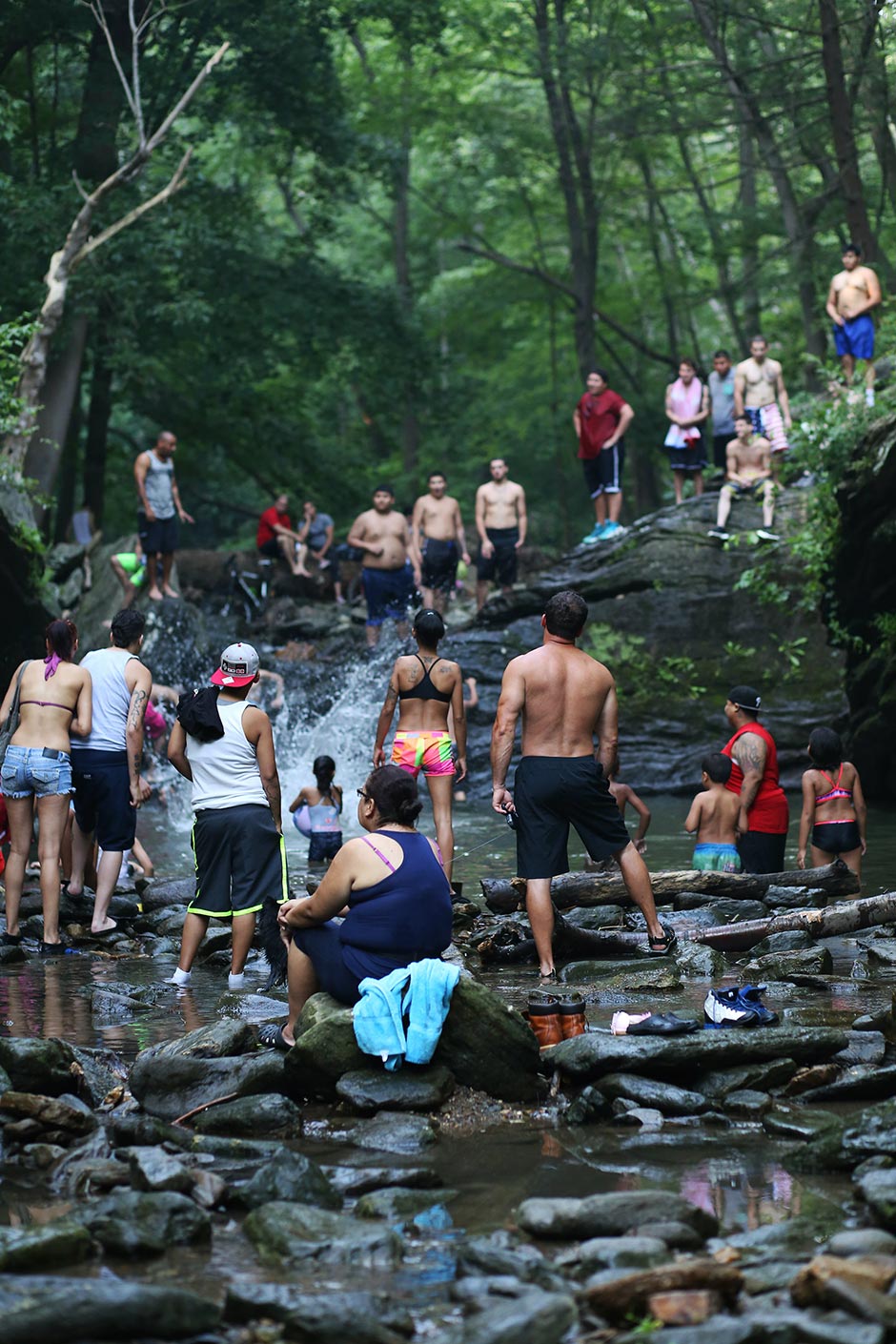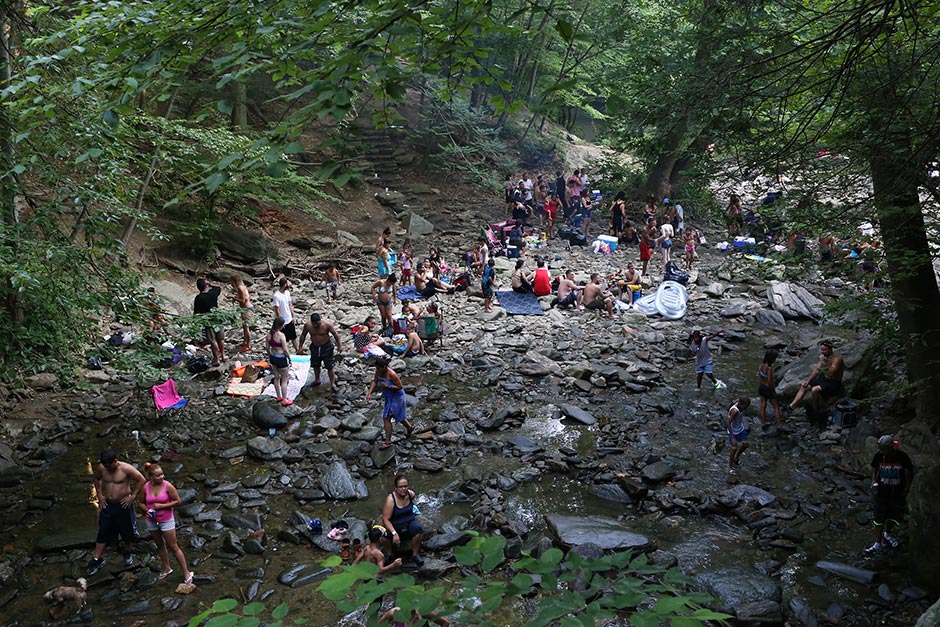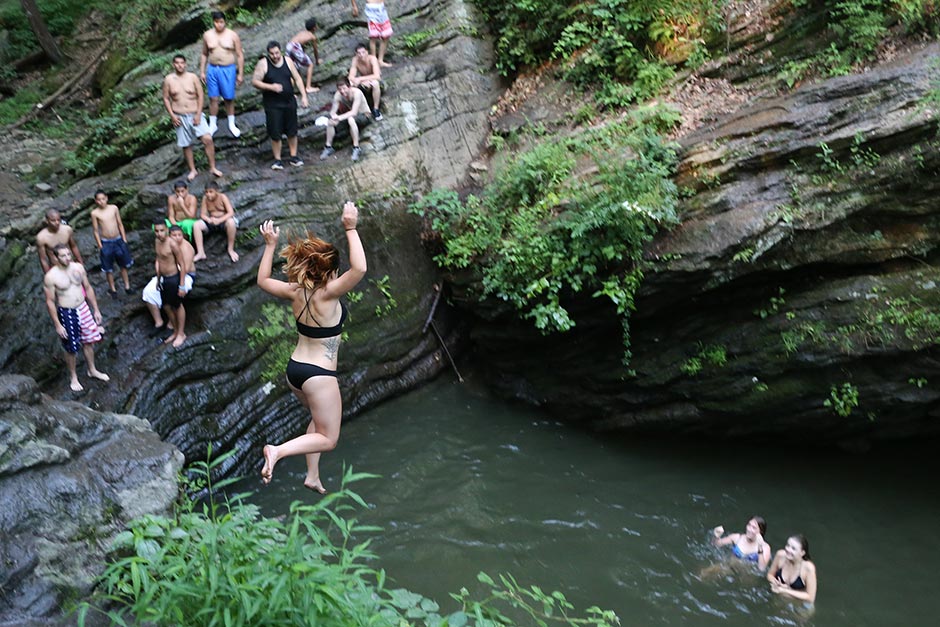The Eternal Lure of Devil’s Pool
Thanks to social media, the Wissahickon's legendary swimming hole is becoming more popular — and more dangerous. Stakeholders have proposed everything from better monitoring to better signage to filling it with rocks. How to preserve a problematic natural treasure?

Photo | Kara Milstein
IN THE WOODS OF Valley Green, just minutes off Livezey Lane in Northwest Philadelphia, the small, bubbling Cresheim Creek cascades into a basin that swells between mossy, fern-covered cliffs before emptying into the Wissahickon Creek. Twentysomethings clad in swim trunks, neon bikinis and muscle tanks linger on the boulders, congregating in groups.
Welcome to Philly’s notorious Devil’s Pool.
On some days, the air at the swimming hole might smell faintly of garbage. Today, it smells like rain. “Trap Queen” blares through someone’s speakers.
Despite an impending downpour, some 40 to 50 people have gathered at the waterfall pool. When it’s sunny and the temperature’s high, there could be close to a hundred. Every minute or so, someone leaps, dives or cannonballs from the moss-coated rocks above and hits the water with a smack.
For those who can’t afford a beach trip or a swim club membership, the site might feel like a sort of hidden urban haven. And while Philadelphia offers 72 public pools — more per capita than any other city in the country — there’s an allure to Devil’s Pool and parts of the Lower Wissahickon nearby that no public pool can claim. It’s hidden. It’s secluded. You almost forget you’re so close to the concrete jungle.
The pool has always been a conundrum, but as it becomes increasingly popular on social media (it’s often touted as a rite-of-passage or mysterious destination), its popularity — and the size of its crowd — grows.
But make no mistake — it’s illegal to swim in Devil’s Pool, or in any of Philadelphia’s rivers or streams, for so many reasons, including a lack of supervision and poor water quality.
And then there’s the issue that some jumpers, like Anthony Cano, don’t resurface so easily.

Photo | Kara Milstein
ON A SUNNY DAY in May of 2013, Blue Bell’s Anthony Cano skipped school to visit Devil’s Pool. He was 18. It was his senior year at Wissahickon High School. He spent about two hours at the pool with friends, lounging and jumping from what he called the “little cliffs” — the boulders surrounding the waterfall pool, which allow swimmers anywhere from a 5- to 15-foot jump into the water.
But, for those who are daring (or foolhardy) enough, there’s another option. About 50 feet above the waterfall, there’s a bridge. It certainly adds to the beauty of Devil’s Pool — the old stone arch, built in the 1890s, curves directly overhead — but it also makes the site potentially deadly.
After a heavy rain, the pool is about 15 feet deep. But the area that jumpers want to aim for — where the water’s deepest — is remarkably small. It’s a questionable jump from 15 feet, but from 50 feet up, it’s incredibly difficult to land safely.
After Cano saw a group of men jump successfully from the bridge, he and his friend decided they would try it out. They shook on it, and about 30 minutes later, they found themselves at the top.
A chanting crowd had formed below, counting down in unison…
5…
4…
3…
2…
Cano’s body flailed as he plummeted. He hit the water and knew instantly he’d landed in the wrong position — seated, butt-first. He says a burst of adrenaline allowed him to push up with his legs from the sandy bottom of Devil’s Pool. But when he broke the surface, he was in too much pain to swim.
A group of girls maneuvered him to the rocks, and then, within seconds, yellow bruises flowered on his back. He could barely move his limbs. Once EMTs got him to Einstein Medical Center, the damage became clear: He’d punctured a lung, fractured his L1 and broken his neck.
Still, he was lucky to survive. He landed in the water. After a month of rehabilitation — and with a metal plate inserted into his back — he learned how to walk again. Others haven’t been as fortunate. In 2013, a father and son drowned in the Wissahickon near Livezey Dam, about a tenth of a mile downstream from Devil’s Pool.* At the time of their deaths, NBC10 reported that 17 people had been rescued from the Wissahickon since 2010.
Anthony Kowalski, a police diver for 19 years, says that the situation in the area around Devil’s Pool has worsened in the last five years. He says the increased popularity via social media has led to bigger, rowdier crowds, and a greater potential for dangerous behavior. (See video below of two people making the same jump that injured Anthony Cano.) He’s visited the pool twice — once four years ago on a rescue mission and once to survey the area for a film crew. He says he and other divers have encountered rusty, discarded bikes and shopping carts in the Wissahickon riverbed.
“It’s not safe — it’s not meant to be swum in,” Kowalski says one afternoon, surrounded by several members of the Philadelphia Marine Division, who nod in agreement.
“The next thing you know, you’re impaled on a handlebar,” he continues. “If you dive in there, you might die in there.”

Photo | Kara Milstein
ALEX BARTLETT, AN ARCHIVIST at the Chestnut Hill Historical Society, says no one knows exactly where the name “Devil’s Pool” comes from. But he’s pretty sure it stems from an old legend, a sort of urban myth, that the Native American Lenape tribe considered the pool an interface between good and evil.
The site is maintained by Friends of the Wissahickon, a 1,600-member non-profit preservation organization. FOW executive director Maura McCarthy says Devil’s Pool is the most trafficked area in the Wissahickon Valley Park. The organization last tallied visitors in 2012, counting 400 people in about a 10-hour time span — and only those trekking from Valley Green Inn, one of the two entrances (the pool can also be accessed from Livezey Lane). Devil’s Pool sits at the intersection of three Philadelphia neighborhoods — Chestnut Hill, Mount Airy and Roxborough — but it also attracts people from hours away, McCarthy says.
It’s difficult to keep track of such an influx of people. The vast majority of injuries at the pool, like broken bones (which McCarthy says are most common), go unrecorded. And because of the way the city gathers crime and accident statistics, the injuries that are recorded aren’t necessarily attributed to Devil’s Pool or even to the park itself. There’s no official address system for locations within Wissahickon Valley Park, so incidents that occur inside the park, like at Devil’s Pool, are appended to the closest physical address, often in the 5th or the 14th districts.
For this reason, it’s difficult to know exactly how many people have died or been injured at Devil’s Pool, though McCarthy says she could think of at least three incidences when FOW has had to call emergency services.
This month, FOW is implementing signs and kiosks at several locations inside the park — each of which will establish a physical address that will become visible on the EMS system. McCarthy says the system “will help in the aftermath, but it’s not going to prevent anything.”
While emergency services will be better able to locate the injured, the rocky, five-minute hike to and from the street nearest Devil’s Pool (which ends just outside the Glen Fern house) won’t become any easier. And it also doesn’t help that the pool is a black hole for cell-phone reception, so emergency calls are hard to make. The Philly Police Marine Division’s Kowalski says the chances of getting to a severely injured person at Devil’s Pool in a crucial time frame are slim to none.
None of that has kept Cano from returning to Devil’s Pool. He’s even jumped from the rocks. But he says he’d never attempt to jump from the bridge again — and he wouldn’t recommend it either.
“It’s like playing Russian roulette,” he says.

Photo | Kara Milstein
THE WATER AT DEVIL’S POOL is clearer than throughout most of Wissahickon Valley Park. At times, it even looks pristine — but it’s far from it. A soggy T-shirt, a sock or two, plastic take-out bags and candy wrappers litter the rocks beneath the waterfall pool like fallen leaves. A can of Bud Light sits in the creek bed, stained brown by silt but glinting in a small patch of sunlight.
“Historically, the pool is seen as a romantic, kind of an unusual place,” archivist Alex Bartlett says. “But the 20th century has brought some problems.”
To start, there’s the lesser-known, less visible pollution. Four wastewater treatment plants use the Wissahickon — which flows some 50 yards away from Devil’s Pool and is generally used as part of one contiguous swimming area — as a discharge point for treated effluent. In extended periods of dry weather, as much as 90 percent of the creek is treated effluent, FOW’s McCarthy says. And the bridge Cano jumped from? It’s actually a gravity sewer.
There are also several corporate industrial plants upstream, where accidents “occasionally do happen,” McCarthy says. In June of 2006, pharmaceutical company Merck & Co. Inc. was responsible for a potassium thiocyanate leak that killed 1,000 fish, shut down drinking-water intakes on the Schuylkill and canceled recreational activity on the Wissahickon for nearly a month. The chemical was in the stream for 18 hours and it took people a week to figure out what happened.
“In that time, people are swimming, they have their kids there, they’re eating the fish there,” McCarthy says. “It is cleaner than it used to be, yes, but there’s still a really long way to go. So when I see little kids in the creek, I get really nervous.”
And then there’s the visible pollution. Bartlett says Devil’s Pool started to suffer from neglect and abuse around 1965. A quick Google search for Devil’s Pool culls dozens of blog posts and articles expressing disdain for the amount of trash the site accumulates.
For a short time period, FOW subsidized police patrol of Devil’s Pool in hope of preventing injuries and pollution. After some swimmers complained about language barriers, officers planted no-swimming signs in Spanish near the pool to cater to Spanish speakers, who they said make up a large portion of the pool-goers. Officers would blitz the area and send people packing, but crowds would disperse only to return in a matter of minutes, Marine Division Lt. Andrew Napoli says.
McCarthy says she found the police presence to be somewhat unsuccessful. And the goal, she emphasizes, isn’t necessarily to keep people away from Devil’s Pool.
“We want to engage the community and make them feel welcome and like this is their space too,” she says. “The police officers let us know that their presence can be polarizing.”
To replace the police officers, encourage safe use and and help clean up trash, FOW decided to employ a seasonal crew this summer, whom McCarthy described as “friendly young people wearing FOW T-shirts.” Between 9 a.m. and 4:30 p.m. on Friday-Monday, their job is to clean the area (which after a busy day resembles a dumping ground) and mingle with swimmers. McCarthy says they’re more effective than police at keeping wild divers at bay.
“The officers let me know they have a role, certainly in enforcement, but they’re not that day-to-day presence that you want to use to sort of change a culture,” McCarthy says.

Photo | Kara Milstein
THERE’S AN IDEA FLOATING around among the police divers, FOW and the Department of Parks and Recreation: Fill the swimming hole. Bring in rocks. Eliminate the problem.
The divers think it’s a good idea. Chris Palmer, the Parks and Recreation Deputy Commissioner for Operations, says it’s been done before at other swimming holes, and it’s worked successfully.
“We have a major issue in the Wissahickon with swimming in Devil’s Pool,” Palmer says. “We’ve worked really hard with a number of solutions, and we just can’t be there all the time to protect the public from their own doing.”
FOW does not support the idea.
“You’re really permanently altering a historic environmental feature to curb the behavior of a relatively small number of people,” McCarthy says. “Not that their lives aren’t important, but also there are a lot of people who use the pool in a non-dangerous way. Is it fair to curtail that use because you have a handful of people using it ignorantly?”
And those who use it care about it. Rosemary O’Connor, 20, is a member of the FOW seasonal crew. Despite the fact that she spends four days a week cleaning up trash from the pool-goers, she says it’s evident that people are very much invested in the site — families, especially children, will often pitch in and help out.
“This is public property,” McCarthy says. “It belongs to all the people swimming just as much as it belongs to you or me.”
“I understand the desire very clearly,” she adds. “I wish this was the right resource to match it up to, I really do, because it looks so appealing. But it’s really just not.”
Andrea Bussart, 17, and Jessica Then, 18, have been rock jumping at Devil’s Pool for two years. They’ve been here more than 20 times.
“It’s something to do,” Bussart says.
Her friends are taking turns scaling the rocks and leaping around us. There’s a thin trail of fresh blood trickling down her leg from where she skinned her knee while jumping. “It’s fun,” she adds, “It’s adrenaline.”
I mention the water quality. “Just don’t swallow it,” Then says, laughing.
*This story originally stated that the father and son who died in 2013 drowned in Devil’s Pool itself.
Follow @ClaireSasko on Twitter.


